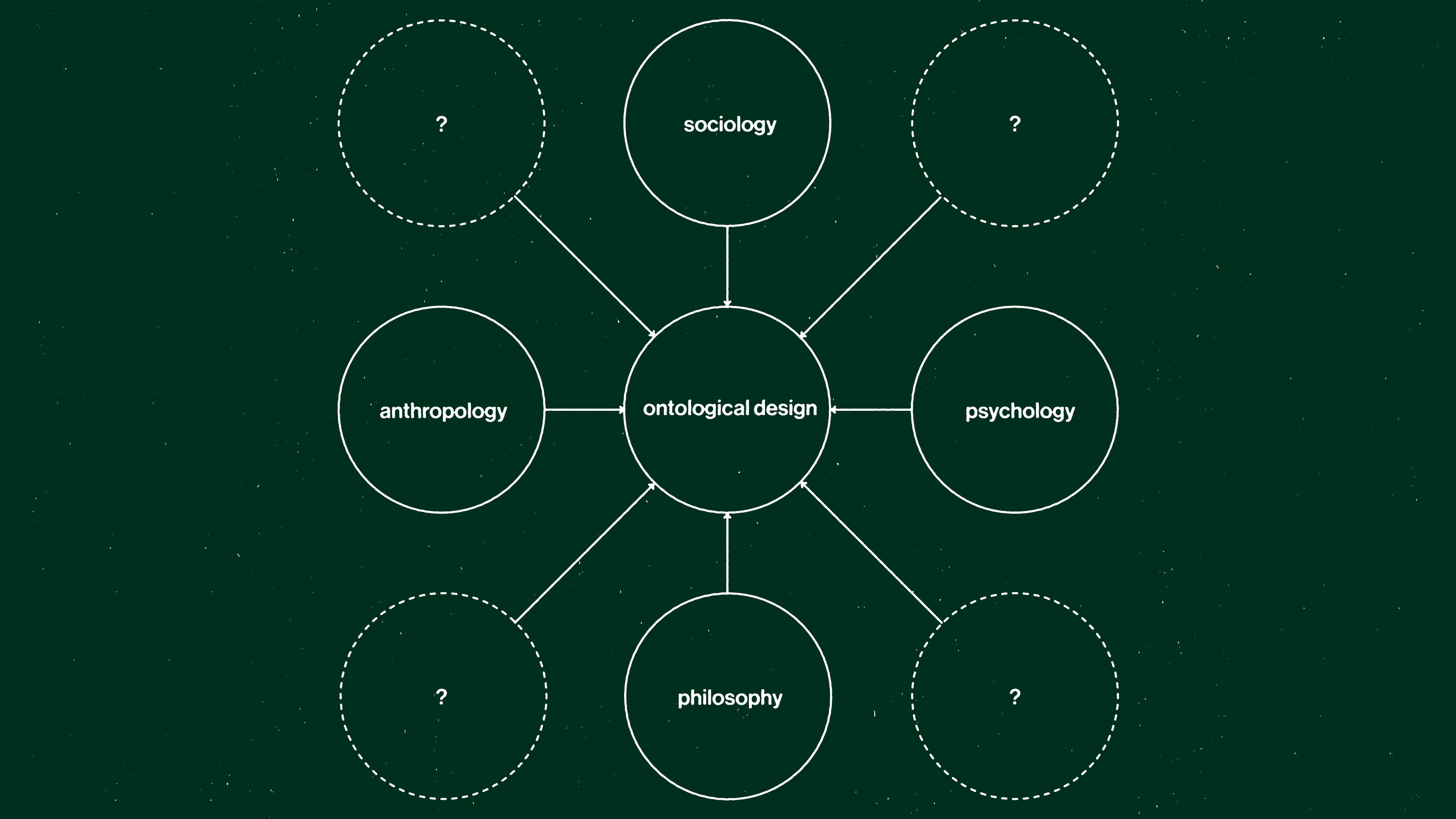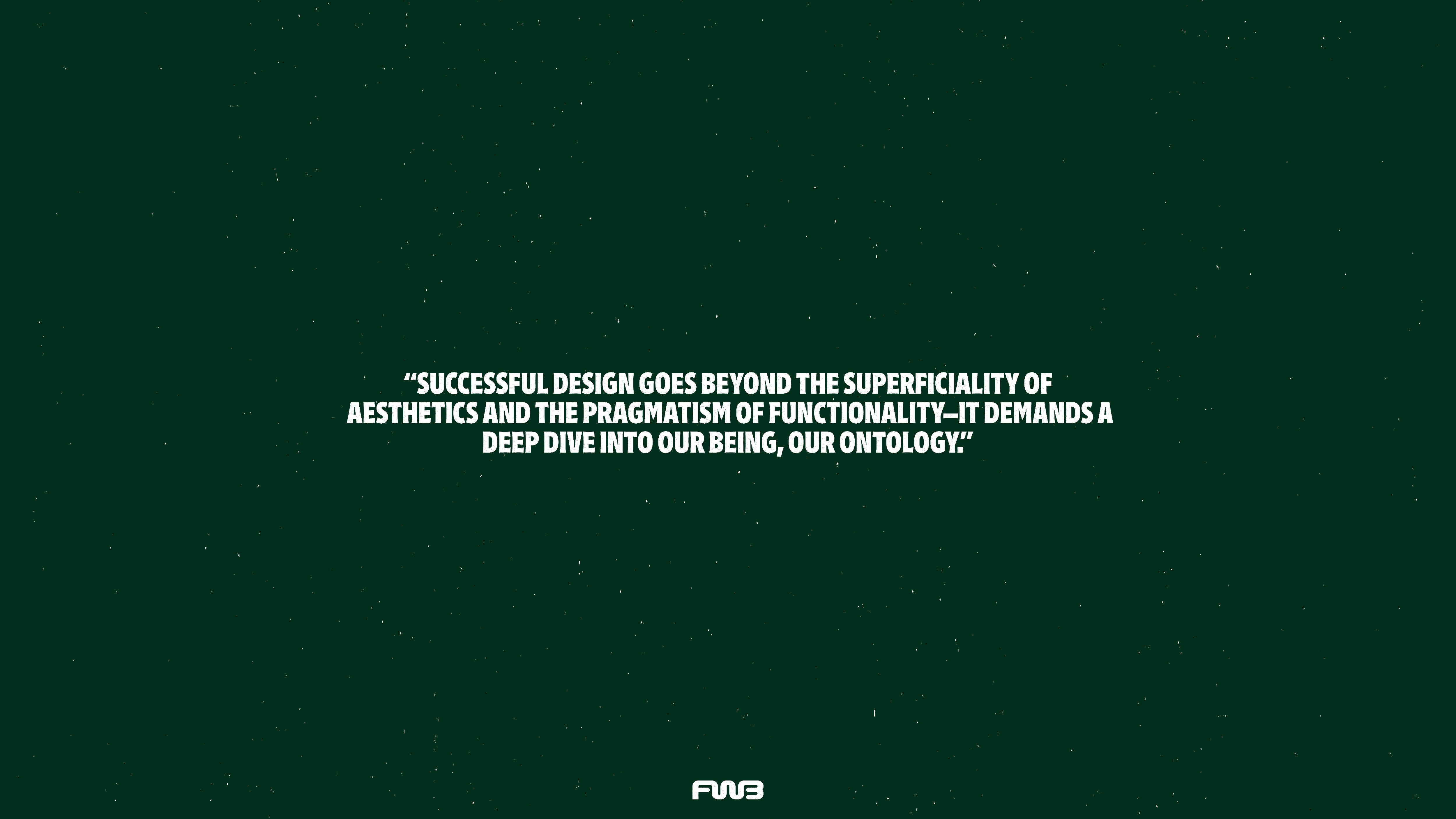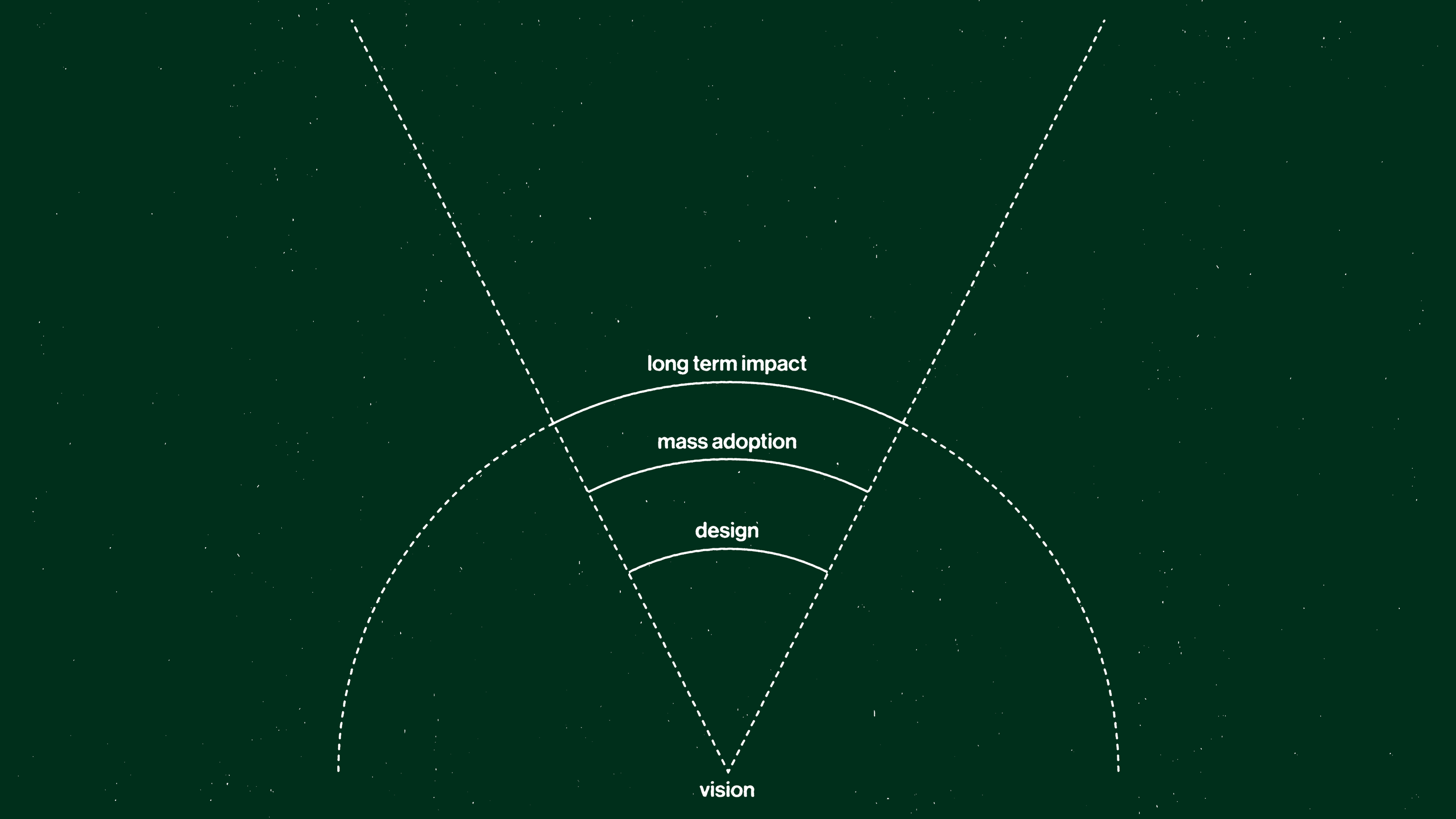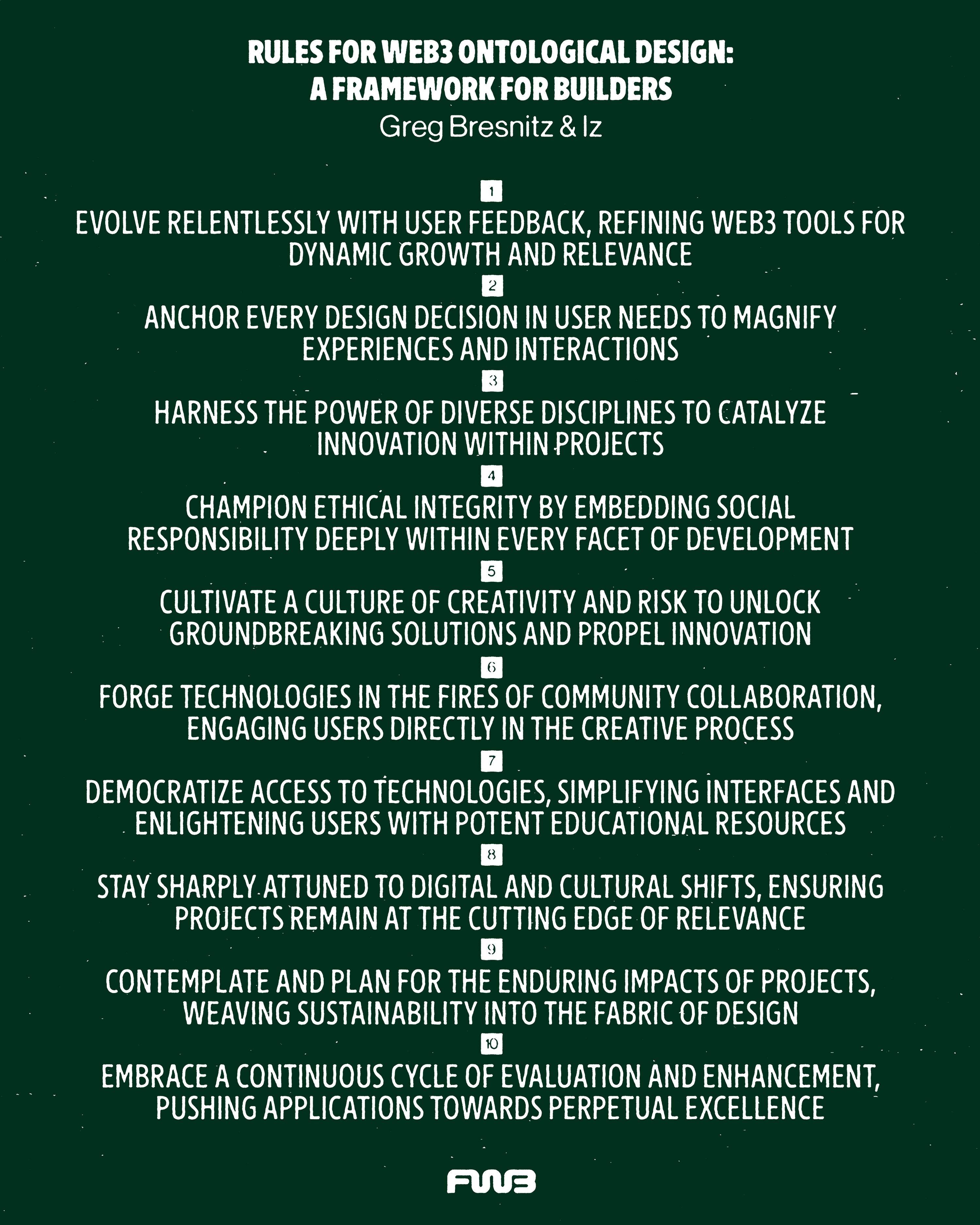- Aleph
- Anna Gat
- Ariel LeBeau
- Austin Robey
- David Blumenstein
- David Ehrlichman
- David Kerr
- Devon Moore
- Dexter Tortoriello
- Drew Coffman
- Drew Millard
- Eileen Isagon Skyers
- FWB Staff
- Gaby Goldberg
- Greg Bresnitz
- Greta Rainbow
- Ian Rogers
- Jessica Klein
- Jose Fernandez da Ponte
- Jose Mejia
- Kelani Nichole
- Kelsie Nabben
- Kevin Munger
- Khalila Douze
- Kinjal Shah
- Kyla Scanlon
- LUKSO
- Lindsay Howard
- Maelstrom
- Marc Moglen
- Marvin Lin
- Mary Carreon
- Matt Newberg
- Mike Pearl
- Mike Sunda (PUSH)
- Moyosore Briggs
- Nicole Froio
- Ruby Justice Thelot
- Ryne Saxe
- Simon Hudson
- Steph Alinsug
- The Blockchain Socialist
- Willa Köerner
- Yana Sosnovskaya
- Yancey Strickler
- iz

Mon May 27 2024
“Once the comfortable fiction of an originary human agent evaporates, the inscriptive power of the designed is revealed and stands naked.”
- Anne-Marie Willis, “Ontological Designing”
“When we imagine a crypto that is more integrated into social life, we don’t think of an uncorrelated economy accessed through screens, but of non-extractive media of exchange and real value production that are more seamlessly integrated with our daily institutions, supportive of the interactions, organizations, and social lives we already live.”
- Other Internet, “Crypto’s Three Body Problem”
"Even the largest avalanche is triggered by small things."
- Vernor Vinge

We are surrounded by remarkable technological advancements, advanced tooling and infrastructure. However, without accounting for culture or desire, these tools fall flat, lacking the spark that transforms pure functionality into meaningful creations. Successful design goes beyond the superficiality of aesthetics and the pragmatism of functionality—it demands a deep dive into our being, our ontology.
This is a call to integrate social and cultural contexts into our technology.
In “Ontological Designing”, Anne-Marie Willis introduces the concept of Ontological Design, articulating that “we design our world, while our world acts back on us and designs us.” Ontological Design describes the relation act of shaping and being shaped by what we build. It is one approach to Other Internet’s “Three Body Problem.” Crypto's struggle with its inherent challenges—where norms, regulatory, markets, and code often conflict—highlights a critical need for a design philosophy that transcends technical frameworks, embracing the nuance of human values and social norms.

The Principles of Ontological Design
Willis’ theory of Ontological Design asks us to redefine our relationship with the world. It posits that "design is fundamental to being human.” Design is a reflection of our essence, and imprints upon our identity through our creations. The core tenants of Ontological Design include:
- Reciprocity: We are in a constant state of co-creation with our environment. Our designs shape our world, and in turn, that world shapes us.
- Humanism: Design is an innate human activity, not just a profession. It is an existential act, deeply embedded in our interactions with the world.
- Hermeneutics: Understanding and interpretation are central to design. This process is cyclical, where our understanding of the whole informs our perception of the parts, and vice versa.
- Ethics: Design carries an inherent ethical and social responsibility.
We can investigate the application of an Ontological Design approach by assessing the presence or lack of these attributes:
- Coevolution: Humans and their tools evolve together. As we evolve, we create new tools that further shape our evolution.
- Reflexivity: Everything designed, from physical spaces to digital interfaces, influences our experiences and our understanding of the world. We exist in a feedback loop with our creations.
- Intentionality: Design decisions should be deliberate and recognize their enduring direct and indirect impact on society.
- Interdisciplinary: Design that embraces our humanity is inherently interdisciplinary, blending insights from philosophy, psychology, sociology, anthropology, and more.

Ontological Design in the Wild
Here, we evaluate how the characteristics of Ontological Design show up in well-known cultural institutions.
Momofuku
"We're not trying to please everybody. We're not cooking for critics. I cook for customers. If I started cooking for critics, I'd probably be really miserable." - David Chang
David Chang’s holistic design choices—from culinary innovations to ambience to operations—for his Momofuku restaurants shape the experience and behaviors of its patrons.
- Coevolution: Chang introduced the pork bun at Momofuku Noodle Bar, captivated diners, and set a new trend in the culinary world. As diners embraced new flavor profiles via the pork bun, Chang evolved his menu, embracing the interplay between his creations and guests’ expectations.
- Reflexivity: Chang adapts Momofuku’s menu based on diner feedback and culinary trends, including expanding the initial ramen offerings from a rich pork broth to include locally sourced ingredients.
- Intentionality: Momofuku establishments intentionally merge minimalist and utilitarian aesthetics to redefine the dining experience. At Momofuku Ssäm Bar, the interior choices reflect the disruption of traditional dining boundaries, encouraging diners to engage with their surroundings in a manner that complements the inventive dishes served. This approach to design, focusing on simplicity and functionality, has set a new standard in the restaurant industry, emphasizing the interconnectedness of culinary art and spatial aesthetics.
- Interdisciplinary: Lucky Peach, Chang’s magazine, broke the mold of traditional food writing focused on recipes. It draws upon anthropology, history, science, and art to examine food culture with essays, interviews, and insights from chefs, scientists and artists.
Ace Hotel
“There’s a lot of pieces of the puzzle. It is not just an interesting design, it is not just the right choice of typeface, it is not finding the right executives or team — it is all those pieces of the puzzle. I love putting all those pieces of the puzzle together.” - Alex Calderwood
Ace Hotel designs spaces that respond to and shape guests' experiences, perceptions, and behaviors within a local culture and community.
- Coevolution: Each Ace Hotel uniquely mirrors its environment, incorporating local aesthetics and heritage into its design. For instance, Ace Hotel Kyoto is nestled in a historic building blending traditional Japanese architecture with modern design elements, celebrating Kyoto’s rich cultural past and vibrant contemporary art scene. Meanwhile, Ace Hotel Brooklyn draws from the borough’s dynamic, eclectic energy, featuring locally sourced materials and artworks that reflect Brooklyn’s renowned artistic community.
- Reflexivity: Ace Hotel adapts its design and offerings based on locals feedback and local trends. The Palm Springs hotel, for example, features mid-century modern decor and desert plants, responding to both environmental and aesthetic feedback from guests, ensuring relevance and community alignment.
- Intentionality: Ace Hotel actively collaborates with local artisans and businesses to deepen the guest experience while promoting local economies. The Sydney location, for example, showcases bespoke furniture and decor created by Sydney-based designers, and offers a curated selection of goods from local suppliers, connecting guests with the authentic Sydney lifestyle. Similarly, Ace Hotel Toronto integrates elements of Canadian craftsmanship and culture, providing a platform for local artists and businesses to engage with guests and the broader community.
- Interdisciplinary: Ace Hotel's cultural programming bridges the gap between guests and locals by hosting diverse events such as indie music shows, craft fairs, and poetry readings. This approach not only entertains but also educates guests about the local culture, turning the hotel into a cultural hub.

Spotify
"We’re really in the business of trying to figure out the future of music and how to create the best possible experience for both users and artists. We don’t just want to be a utility. We want to be something that brings emotion. That’s what music is about." - Daniel Ek
Spotify stands to benefit from the principles of Ontological Design applied to its algorithms, curation mechanisms, and relationship with artists.
- Coevolution: Spotify encourages artists to produce music that primarily resonates with its algorithms that are fine-tuned to user engagement and optimization.
- Reflexivity: Spotify’s feedback loops reinforce the prevalence of artists and tracks that are already popular or algorithmically optimized, diminishing the variety and richness of the musical landscape.
- Intentionality: Spotify's design is intentional in curating user experience, but it's focused on user retention and engagement, prioritizing commercial success and predictability over artistic diversity.
- Interdisciplinary: Spotify's algorithmic design likely over-indexes on big data and user behavior, overshadowing the intrinsic value and depth of culture and history within music.
Ontological Design Meets Crypto
The future of crypto lies in its ability to resonate as a technological breakthrough that addresses our collective aspirations and values. As crypto evolves from ideas to mainstream adoption in the next five years, Ontological Design offers the following directives:
- Coevolution: For crypto to resonate with the hoi polloi, it must meet users where they are within existing infrastructures that may already have strongly embedded or understood social norms and evolve in lockstep with adoption.
- Reflexivity: Crypto products need earlier and more frequent feedback loops between users and builders to cultivate better experiences, deeper trust, and recurring engagement.
- Intentionality: Builders should consider how their decisions foster connection, encourage autonomy, and empower users rather than alienate them.
- Interdisciplinary: Drawing from fields like psychology, media, cultural study, sociology, and anthropology, can provide deeper insights into human behavior and societal trends. Understanding the cultural context and human desires can guide the creation of web3 applications that resonate on a deeper level with users, facilitating broader adoption.

Uniswap
"Building Uniswap has been about constant iteration and feedback from the community. Every change we implement aims to enhance user experience and optimize the protocol's efficiency.” - Hayden Adam
Uniswap's design choices—from its user interface to its governance protocols—significantly shape the trading experiences and behaviors of its users.
- Coevolution: Uniswap has evolved alongside its users, beginning as a simple automated market maker and growing into a complex platform with enhanced features such as concentrated liquidity and tiered fee structures. This evolution reflects the platform’s responsiveness to the needs and feedback of its community, ensuring that as users' expectations grow, so does the functionality and efficiency of the protocol.
- Reflexivity: Uniswap continually adapts its protocol based on user interaction and the broader DeFi ecosystem's dynamics. Changes like the introduction of Uniswap V3, which offers more flexibility in fee structures and increased capital efficiency for liquidity providers, are responses to user feedback and market demands. This reflexive approach helps maintain its relevance and utility in a rapidly evolving market.
- Intentionality: Uniswap is designed to facilitate decentralized and permissionless trading of tokens. Its trustless design minimizes reliance on traditional financial intermediaries, empowering users with direct control over their trading actions. The protocol’s development from V1 through V3 demonstrates a focused intention to enhance user experience and maximize efficiency, reflecting a clear vision for the future of decentralized exchange.
- Interdisciplinary: The Uniswap ecosystem encompasses a diverse range of contributors including developers, traders, liquidity providers, and governance participants. This community draws on expertise from fields such as economics, cryptography, software engineering, and governance to inform the protocol’s design and evolution. Interdisciplinary collaboration ensures that Uniswap remains at the forefront of DeFi innovation and is well-integrated within the broader blockchain and financial landscape.
Blackbird
“Connectivity between restaurants and guests has eroded. There’s a difference between knowing it’s someone’s birthday and being able to contact that person and invite them in for a drink.” - Ben Leventhal
Blackbird transforms traditional loyalty systems and fosters a more interactive and valuable relationship between consumers and businesses.
- Coevolution: When users earn and spend $FLY points at restaurants, their engagement directly influences the value and utility of $FLY, prompting ongoing enhancements in Blackbird's system and the participating restaurants' offerings.
- Reflexivity: Data gathered, such as dining preferences and frequency, aids restaurants in customizing their service and rewards, enhancing user satisfaction and deepening the relationship between diners and establishments. For example, chip readers under restaurant tables detect members' presence, triggering tailored rewards and alerts.
- Intentionality: Blackbird fosters a connected food ecosystem by empowering diners to accrue and redeem points across a network. This encourages exploration and engagement across a local culinary scene.
- Interdisciplinary: Much like how Momofuku's Lucky Peach magazine bridged the gap between culinary practice and cultural narrative, Blackbird is pioneering a similar interdisciplinary approach through its own editorial platform. This initiative gathers chefs, food critics, writers, and celebrities to delve into broader discussions about food culture, sustainability, and culinary trends. By doing so, Blackbird enriches the dialogue around its partner restaurants, offering more than just loyalty rewards by embedding these eateries within a larger cultural and gastronomic context.

Looking Forward
Ontological Design principles urge us to embrace a future where technology is both functional and intertwined with our collective human aspirations. This approach promotes a symbiotic relationship between us and our creations, ensuring that our innovations resonate with and enhance our human experience. Let us actively engage as co-creators, shaping and being shaped by the tools and environments we develop. This is a call to action to integrate, innovate, and inspire a world where technology genuinely serves humanity, steering us toward a more thoughtful, inclusive, and responsive future.
Rules for web3 Ontological Design: A Framework for Builders
Inspired by FWB's Event Pattern Language



